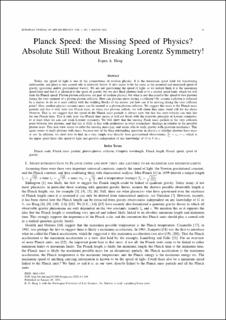| dc.description.abstract | Today, the speed of light is one of the cornerstones of modern physics. It is the maximum speed limit for transferring information, and plays a very central role in relativity theory. It also seems to be the same as the assumed and measured speed of gravity (gravitons and/or gravitational waves). We are not questioning the speed of light, as we indeed think it is the maximum speed limit and that it is identical to the speed of gravity, but we also think photons lead us to a second speed limit, which we will term the Planck speed. Photon-photon collisions are part of modern physics, but what is not discussed is the speed of two photons during the very moment of a photon-photon collision. How can photons move during a collision? Or, assume a photon is reflected by a mirror; to do so it must collide with the building blocks of the mirror, yet how can it be moving during the very collision point? Also, modern physics assumes mass can be created in a photon-photon collision. We suggest this mass is the Planck mass particle and that it only lasts one Planck time, so when two photons collide, we will claim they must stand still for the direct observer. That is, we suggest that the speed of the Planck mass particle is always zero, but that this zero-velocity can only last for one Planck time. That it only lasts one Planck time means it will not break with the relativity principle or Lorenz symmetry, or at least what we can call weak Lorentz symmetry. We will show that the missing Plank mass particle is the very collision point between two photons, and that this is fully in line with predictions in other researchers’ findings in relation to the possible photon mass. This new view seems to solve the missing mass-gap, and seems able to unify gravity with quantum mechanics. This again seems to unify photons with mass, because one of the long-outstanding questions in physics is whether photons have mass or not. In addition, we show how to find, in a very simple way directly from gravitational observations, lp/tp= cg = c, which is the upper speed limit (the speed of light and gravity) independent of any knowledge of G or h or c. | en_US |
